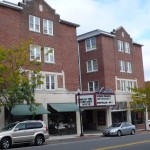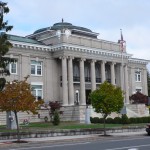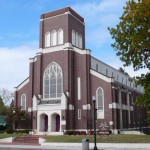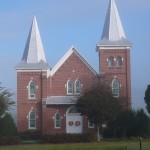by Dwayne Phillips
Today we walked through Atkins and Marion, Virginia. The weather was lousy again this morning. It is cool and wet so you wear a rain jacket, but it is also warm enough that you perspire heavily under the jacket. Ick. We covered 12 miles.
Atkins is a wide place in the road, but much bigger than the ones we have traversed so far. It has a Post Office, a school, 100+ house trailers, several dozen homes, and two factories. I was surprised. I put a photo of the Atkins Post Office on the Wikipedia page for Atkins.
Atkins and Marion are within five miles of one another, but are worlds apart. Marion is the  classic Main Street town. Route 11 is the Main Street. Downtown Marion is about six blocks long. It is in great shape with stores, restaurants, other businesses, and churches. Here is a photo of the Smyth County Courthouse and the Lincoln Theater.
classic Main Street town. Route 11 is the Main Street. Downtown Marion is about six blocks long. It is in great shape with stores, restaurants, other businesses, and churches. Here is a photo of the Smyth County Courthouse and the Lincoln Theater.
Also in Marion is the Royal Oak Presbyterian Church (shown below to the left). The building was built in 1923. The Church was formed in 1776. The same year as, well, you know.
Visit Marion if you are in far Southwestern Virginia. They have put much effort into their downtown, and it shows. I put a photo of the restored Lincoln Theatre (on Main Street) on the Wikipedia page for Marion.
Here is another church we passed on Route 11. It is St Paul’s Lutheran Church (below and to the right). The building was finished in 1916, and the church itself was formed in 1776. What amazes me about St Paul’s is that today it is still out in the middle of no where. It is a few miles from Rural Retreat, Virginia on a side road to a side road. I find it difficult to imagine how far out in the middle of no where this spot was in 1776.
St Paul’s building is impressive, but the history is in the graveyard next to the building. There are many markers from the 1700s. There are also markers from the 1800s with a number of men who died in the Civil War. Some of those inscriptions read that they died “defending their country.”
On the grounds of the Smyth County Courthouse in Marion is a memorial built in 1906. It is for the men who died in the Civil War. It reads “To the defenders of state sovereignty.”
These memorials, built soon after the Civil War by people who were involved in it, express what the people of this region felt. The war was “The War Between the States” and it was fought over states rights. That is not the feeling of most historians of today. That is the feeling of those involved at the time. This is not a comment, just an observation.

0 responses so far ↓
There are no comments yet...Kick things off by filling out the form below.
You must log in to post a comment.